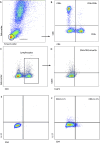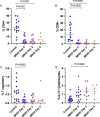Lymphocyte immunophenotype in dogs with immune-mediated hematologic disease
- PMID: 40526723
- PMCID: PMC12173396
- DOI: 10.1371/journal.pone.0326341
Lymphocyte immunophenotype in dogs with immune-mediated hematologic disease
Abstract
Immune-mediated hematologic diseases (IMHD) including immune-mediated hemolytic anemia (IMHA) and immune thrombocytopenia (ITP) can cause severe disease in dogs. The underlying immune system abnormalities associated with these conditions is not known. The hypotheses of this study were that dogs with IMHD would have increased frequencies of CD4+ and CD8 + lymphocytes, decreased frequencies and numbers of T regulatory cells, and increased frequencies of interleukin (IL)-17 + lymphocytes. Fifteen dogs with newly diagnosed IMHA or ITP and 15 healthy control dogs were recruited for this prospective study. Flow cytometry was used to enumerate CD4 + lymphocytes, CD8 + lymphocytes, T regulatory (CD4 + CD25 + Foxp3+) cells, and lymphocytes secreting IL-17 in dogs with IMHD at diagnosis, then 2 and 4 days after starting immunosuppressive treatment. Median proportion of CD4+ (Day 0: 3.4%, Day 2: 3.3%) and CD8+ (Day 0: 1%, Day 2: 0.6%) cells was lower in dogs with IMHD compared to control dogs (CD4 + 22.8%, CD8 + : 13.6%; P < 0.0001 for each). Additionally, T regulatory cells were reduced in IMHD dogs at Day 0 (0.2% versus 0.6% of total lymphocytes, P = 0.0025). Dogs with IMHD had a higher proportion of lymphocytes positive for IL-17 at Day 2 (1.3%) compared to control dogs (0.4%, P = 0.0024). Dogs with IMHD have immune system alterations at diagnosis and during early treatment characterized by a deficiency in T regulatory cells and an increase in IL-17 + lymphocyte. These changes might contribute to the pathogenesis of IMHA and ITP.
Copyright: © 2025 Blois et al. This is an open access article distributed under the terms of the Creative Commons Attribution License, which permits unrestricted use, distribution, and reproduction in any medium, provided the original author and source are credited.
Conflict of interest statement
The authors have declared that no competing interests exist.
Figures


Similar articles
-
Systematic review of prognostic factors for mortality in dogs with immune-mediated hemolytic anemia.J Vet Intern Med. 2015 Jan;29(1):7-13. doi: 10.1111/jvim.12514. Epub 2015 Jan 13. J Vet Intern Med. 2015. PMID: 25586014 Free PMC article.
-
Immunotherapy with low-dose IL-2 attenuates vascular injury in mice with diabetic and neovascular retinopathy by restoring the balance between Foxp3+ Tregs and CD8+ T cells.Diabetologia. 2025 Jul;68(7):1559-1573. doi: 10.1007/s00125-025-06412-8. Epub 2025 Mar 25. Diabetologia. 2025. PMID: 40133487 Free PMC article.
-
Increased effector memory CD4+ T cells are associated with chronic childhood immune thrombocytopenia.J Thromb Haemost. 2025 Sep;23(9):2969-2981. doi: 10.1016/j.jtha.2025.06.004. Epub 2025 Jun 10. J Thromb Haemost. 2025. PMID: 40505868 Clinical Trial.
-
Plasma concentration of thrombopoietin in dogs with immune thrombocytopenia.J Vet Intern Med. 2024 Sep-Oct;38(5):2507-2517. doi: 10.1111/jvim.17152. Epub 2024 Aug 14. J Vet Intern Med. 2024. PMID: 39143652 Free PMC article.
-
Assessing the comparative effects of interventions in COPD: a tutorial on network meta-analysis for clinicians.Respir Res. 2024 Dec 21;25(1):438. doi: 10.1186/s12931-024-03056-x. Respir Res. 2024. PMID: 39709425 Free PMC article. Review.
References
MeSH terms
Substances
LinkOut - more resources
Full Text Sources
Research Materials

